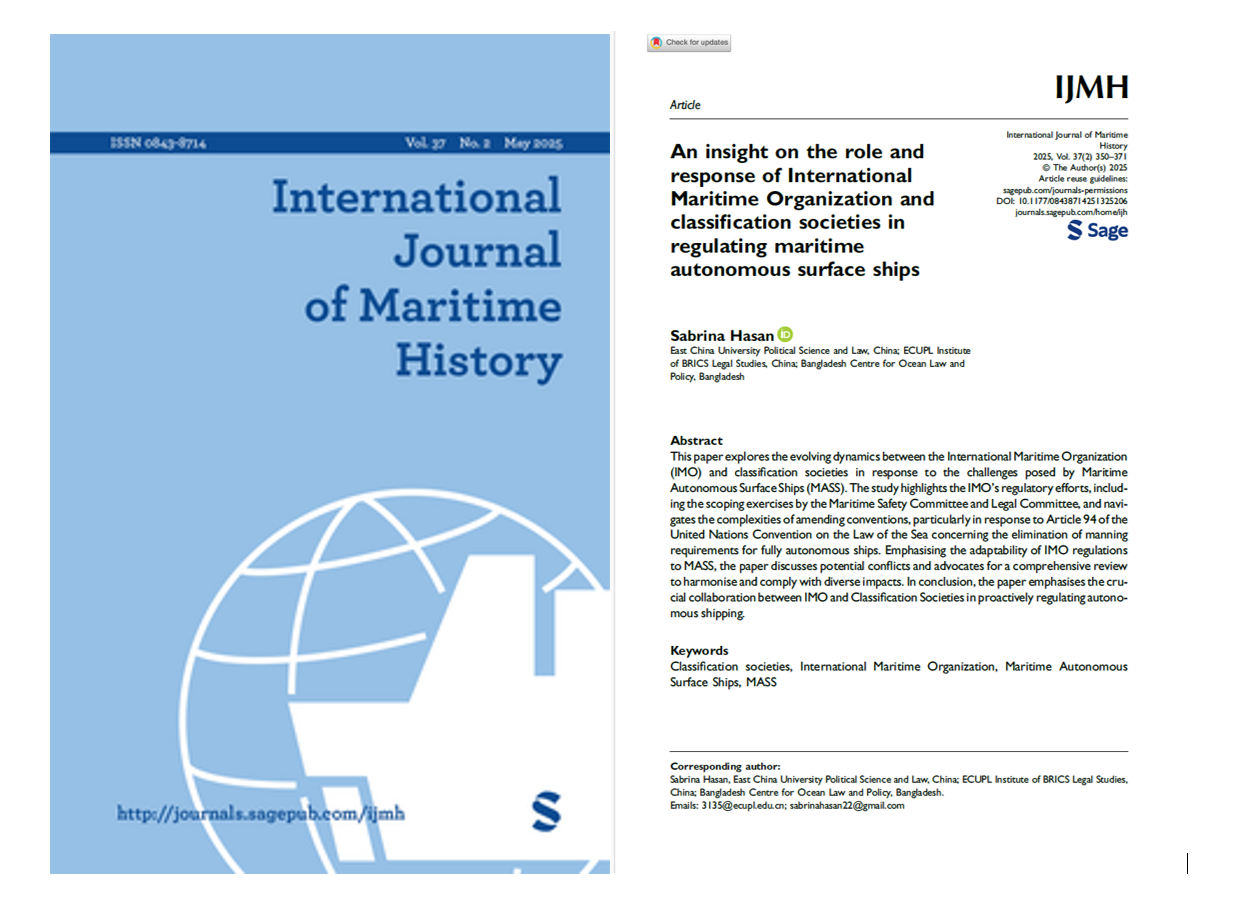Kazi Ayman Awsaf
Introduction
Rising global sea levels present an urgent and complex challenge to international law, particularly concerning maritime sovereignty. This article directly addresses a critical legal question: Do States have an obligation to relocate their coastal baselines in response to climate-induced sea level rise? This article identifies the tension that emerged between rising sea levels and the core principles of the law of the sea. It then turns to an examination of the UNCLOS provisions and the ambiguities concerning such baseline changes and attempts to show how the recent ICJ Advisory Opinion on Obligations of States in respect of Climate Change (hereafter “Advisory Opinion”) provides important clarifications in this regard. It argues for legal fixity and baseline stability as an important response. It then proceeds to explore the evolving customary international law supporting fixed baselines and also considers the Advisory Opinion’s treatment of the deeper question of statehood in the face of total territorial loss.
Sea Level Rise and Baselines under the UNCLOS
For years, the general assumption was that baselines were ambulatory, and hence, they should be drawn inwards with a receding coastline. In a scenario of rapid sea-level rise, this interpretation poses an existential threat to low-lying States, risking the loss of maritime entitlements they previously held. The tension arises from a direct conflict of the physical reality of a changing coastline and the urgent need for legal stability to safeguard national sovereignty, economic rights, and the very existence of vulnerable States. Article 5 of the UNCLOS speaks of baselines ‘as marked on large-scale charts’ at low tide, but says nothing about future shifts.
In its recent Advisory Opinion, the ICJ clarified the ambiguity. It concluded that no UNCLOS provision compels States to update their coastal baseline coordinates or maritime limits after the baseline has been duly established. The Court made it clear that States are under no legal obligation to recalculate baselines or outer limits merely because sea levels rise (para 362). This affirms the right of States to maintain their maritime boundaries as soon as the establishment of the baseline in line with the UNCLOS has been done. This construction confirms the sustainability of maritime areas especially to low-lying States that face existential risks due to the rise of sea levels. It further underscored that in the implementation of their obligations under the UNCLOS, States should consider their applicable duties under climate treaties, environmental treaties and customary international law (para 354).
Given the existential threat posed by rising sea levels, especially to coastal and low-lying States, the principle of legal fixity and the stability of baselines will protect sovereign rights and avoid disputes. In the Sydney Declaration of Principles on the Protection of Persons Displaced in the Context of Sea Level Rise, the International Law Association also stood firmly behind the concept of baseline stability in light of sea level rise, underscoring the emerging view that the ambulatory approach is therefore rendered impractical and unjust. The ICJ Advisory Opinion provided a timely clarification in this regard.
Sea Level Rise and Baselines under Customary International Law
Beyond the UNCLOS, there is evidence showing a fast evolution of customary international law establishing the stability and fixity of maritime baselines, showing an increasing international consensus. A clear example of the practice can be seen in the actions of several Pacific Island States that are most impacted by climate change. Facing the threat of the loss of their territories (land and maritime), these States have enacted domestic laws to create permanent maritime zones. Tuvalu and the Marshall Islands, for example, have issued declarations and passed domestic legislation to the effect that once maritime boundaries have been set, they shall remain fixed and shall not change with coastal changes due to sea level rise.
The issue received considerable attention at the International Law Commission (hereafter “ILC”), the subsidiary organ of the United Nations dedicated to the codification and progressive development of international law. The 2025 report of the ILC extensively documented and analyzed the strong support that has been shown among States towards the retention of baselines in the face of sea level rise, taking into account the far-reaching consequences for small island developing States.
The report makes clear that the practice of fixing maritime baselines is not only widespread but also carried out with a sense of legal obligation. More than a hundred States took part in the discussions at the Sixth Committee, and a consensus on the matter took shape that the UNCLOS does not impose the constant renewal of baselines, nor does it forbid the maintenance of previously established baselines (paras 39-40). It is important to note that many States, particularly those in the Pacific Islands, have passed domestic laws or made declaratory policies of permanence of their maritime areas, and have argued that they consider such acts as their legal rights under international law. By explicitly linking their actions to the UNCLOS and the principle of fixed baseline, these States demonstrate opinio juris, a genuine belief that the law both entitles and compels them to establish fixed baselines.
While the Advisory Opinion did not clearly discuss the customary nature of the issue, Judge Aurescu, who was previously involved in the ILC Study on the sea level rising, in his Separate Opinion categorically asserted that it has become a customary norm that States have no obligation to update their baselines once duly established. Mentioning the 2025 ILC report, amongst others, he asserts that:
[States] perceive the solution of fixed baselines to be not merely a matter of policy discretion or political commitment, but the expression of a legal obligation under international law. At present, there are over 100 States expressly acknowledging that baselines must remain fixed at their current co-ordinates, notwithstanding physical coastline changes brought about by sea-level rise. All of them are convinced that by doing so, they are in strict compliance with their legal obligations since UNCLOS does not obligate States to update the coordinates of their baselines. The abundance and high frequency of State practice in all regions of the world indicate in an obvious and convincing manner, without any shadow of doubt, that the opinio juris has already crystallized. (Separate Opinion of Judge Aurescu, para 11).
This development in customary international law would mean that such a rule is applicable not only to the State Parties to the UNCLOS, but also to other States.
Statehood in case of Total Territorial Loss
Fixing baselines can be a temporary legal way to protect a State’s rights when some of its land is still above water. But the question arises: what happens if the entire territory of a State becomes submerged?
The Court addressed the concerns of the various participants that sea level rise presents a great danger to the territorial integrity and consequently to the very existence of small island States (para 363). Significantly, the Court held that “once a State is established, the disappearance of one of its constituent elements would not necessarily entail the loss of its statehood” (ibid). This statement reflects a presumption of continuity, whereby statehood is not automatically extinguished by the physical loss of its territory.
Judge Aurescu in his separate opinion argues in the same line for the resilience of statehood. He stresses that the disappearance of one or more constituent elements does not affect the existing statehood and also does not involve the loss of membership of the United Nations and of other international organizations (Separate Opinion of Judge Aurescu, para 21). This reflects a paradigm shift toward recognizing de-territorialized statehood. He also situates continuity as a form of restitution under international law, providing an equitable response to climate-driven displacement and territorial loss (para 24).
Standing in stark opposition, Judge Tomka’s declaration upholds the classical concepts of statehood based on the Montevideo Convention. He emphasizes a close connection between statehood and territory and cautions that the deprivation of territory poses a direct threat to the fundamental criteria of statehood: a specific geographical territory, a population, as well as a functioning government and the capacity to enter into relations with other States (paras 3, 7‑9).
Judge Tomka warns that, as much as there is an increasing conviction that the drive to statehood despite territory loss can be achieved, it probably is not yet an established principle of customary international law (para 6). According to Tomka, territory has always been essential to the very idea of a State, and that States are a sociolegal construct, which allowed the exercise of an exclusive power, i.e., sovereignty, over a territory and its people. He argues that non-existence of land would predispose the disappearance of such State as a subject of international law (para 8). This judicial divergence exposes the unsettled nature of international law on this matter, which needs special attention.
Conclusion
The ICJ Advisory Opinion is a major advancement in the law of the sea as it confirms that the UNCLOS does not require States to re-establish their baselines after establishing them to remain stable and secure against rising sea levels, which would threaten the coastal and island States. Judge Aurescu’s Separate Opinion also shows how customary international law has crystallized (or is crystallizing) fast to recognize the permanence of maritime baselines. It showed that fixed baselines are increasingly viewed as a legal obligation (opinio juris) by numerous States (widespread State practice). Simultaneously, the discussion by the Court of statehood in case of total territorial submergence reveals the unquiet state of law: Judge Aurescu sees continuity in the statehood even in the absence of one or more constituent elements, whereas Judge Tomka and some others believe that such approach is contradictory to the settled standards. Whereas the Opinion sheds some important light on maritime baselines, it leaves the more difficult question of statehood without territory unanswered, which will require more legal scrutiny.
Kazi Ayman Awsaf is a third-year law student at East West University. He can be reached at kaziaymanawsaf@gmail.com.







